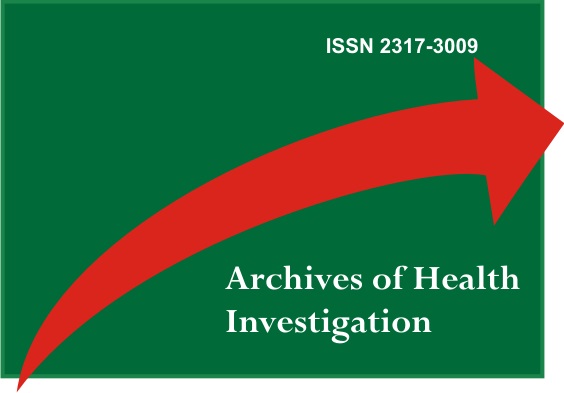Capillary malformation x parafunctional trauma: case report and treatment
DOI:
https://doi.org/10.21270/archi.v10i6.5016Keywords:
Vascular Malformations, Sclerotherapy, Temporomandibular Joint Disorders, Occlusal SplintsAbstract
Vascular malformations are structural abnormalities of blood vessels without endothelial proliferation, they are at birthday and persist throughout life. They can be categorized according to the type of vessel involved (capillary venous, arteriovenous) and according to hemodynamic characteristics (low flow or high flow). They have a variable etiology, such as chemical factors, genetic mutations or changes related to syndromes, blood flow, vascular body resistance and trauma. In this case, the vascular malformation presented by the patient is related to trauma to the cheek mucosa due to the parafunctional activity present. Parafunctional activity refers to any activity that is not considered to be functional, such as clenching and / or grinding your teeth during the day and / or at night, chewing gum, biting your cheek, lips and tongue. Some of these activities may be responsible for contributing to Temporomandibular Dysfunction (TMD), as they promote masticatory muscle hyperactivity. Muscle pain, restriction of mouth opening, sensation of ear fullness, ringing in the ear and vertigo were some of the symptoms presented by the patient. In view of this condition, in addition to treating vascular malformation with a combination of sclerotherapy and surgical excision, the dysfunctional condition was also treated, for its control and resolution, in addition to preventing injury recurrence, with the use of myorelaxant plaque combined with the performance of physical therapy exercises, proving to be effective, containing symptoms, restricting parafunctional activity and reducing trauma to the mucosa.
Downloads
References
Neville BW, Damm DD, Allen CM, Bouquot JE. Patologia Oral e Maxilofacial. 3 ed. Rio de Janeiro: Elsevier; 2009.
Kuriakose MA, Chakrabarti S, Cheong SC, Kowalski LP, Novaes Pinheiro T, Farah CS. Head and neck tumors. In: Farah C, Balasubramaniam R, McCullough M (eds). Contemporary oral medicine. Springer. Cham; 2019.
Buckmiller LM, Richter GT, Suen JY. Diagnosis and management of hemangiomas and vascular malformations of the head and neck. Oral Dis. 2010;16(5):405-18.
Horbach SE, Lokhorst MM, Saeed P, de Goüyon Matignon de Pontouraude CM, Rothová A, van der Horst CM. Sclerotherapy for low-flow vascular malformations of the head and neck: A systematic review of sclerosing agents. J Plast Reconstr Aesthet Surg. 2016;69(3):295-304.
Wassef M, Blei F, Adams D, Alomari A, Baselga E, Berenstein A et al. Vascular anomalies classification: recommendations from the international society for the study of vascular anomalies. Pediatrics.2015;136(1): e203-14.
Li J, Chen J, Zheng G, Liao G, Fu Z, Li J et al. Digital subtractionangiography-guided percutaneous sclerotherapy of venous malformations with pingyangmycin and/or absolute ethanol in the maxillofacial region. J Oral MaxillofacSurg 2010;68:2258-266.
Burrows PE, Manson KP. Percutaneus treatment of low flow vascular malformations. J Vasc Interv Radiol. 2004;15:431-45.
Ozaki M, Kurita M, Kaji N, Fujino T, Narushima M, Takushima A et al. Efficacy and evaluation of safety of sclerosants for intramuscular venous malformations: clinical and experimental studies. J Plast Surg Hand Surg. 2010;44:75-87.
Medeiros SP, Batista AUD, Forte FDS. Prevalência de sintomas de disfunção temporomandibular e hábitos parafuncionais em estudantes universitários. Rev Gauch Odontol. 2011;59(2):201-8.
Bortolleto PPB, Moreira APSM, Madureira PR. Analyses parafunctional habits and association with Temporomandibular Disorder. Rev Assoc Paul Cir Dent. 2013;67(3):216-21.
Okeson JP. Tratamento das desordens temporomandibulares e oclusão. 6. ed. São Paulo: Elsevier; 2008.
Vasconcelos IGS, Venâncio GN, Silva FB. Tratamento de disfunção temporomandibular com placa oclusal: relato de caso. Arch Health Invest. 2018;7(6):205-9.
Okeson JP, De Leeuw R. Differential diagnosis of temporomandibular disorders and other orofacial pain disorders. Dent Clin N Am. 2011;55:105-20.
Marquezan M, Figueiro C. Alternativa de tratamento de disfunção temporomandibular em um paciente portador de prótese total maxilar e prótese parcial removível mandibular: relato de caso. Rev Dentística Online. 2007;7:77-84.
Blanco-Hungría A, Blanco-Aguilera A, Blanco-Aguilera E, Serrano-del-Ro¬sal R, Biedma-Velázquez L, Rodríguez-Torronteras A et al. Prevalence of the different Axis I clinical subtypes in a sample of patients with orofacial pain and temporomandibular disorders in the Andalusian Healthcare Service. Rev Med Oral Patol Oral Cir Bucal. 2016;21:169-77.
Maluf SA, Moreno BGD, Alfredo PP, Amélia Pasqual Marques AP, Rodrigues G. Exercícios terapêuticos nas desordens temporomandibulares: uma revisão de literatura. Fisioter Pesq. 2008;15(4):408-15.
Oliveira KB, Pinheiro ICO, Freitas DG, Gualberto HD, Carvalho NAA. A abordagem fisioterapêutica na disfunção da articulação temporomandibular. Revisão da literatura. Med Reabil. 2010;29(3):61-4.
Peliciol M, Myra RP, Florianovicz VC, Batista JS. Physiotherapeutic treatment in temporomandibular disorders. Rev Dor. 2017;18(4):355-61.


